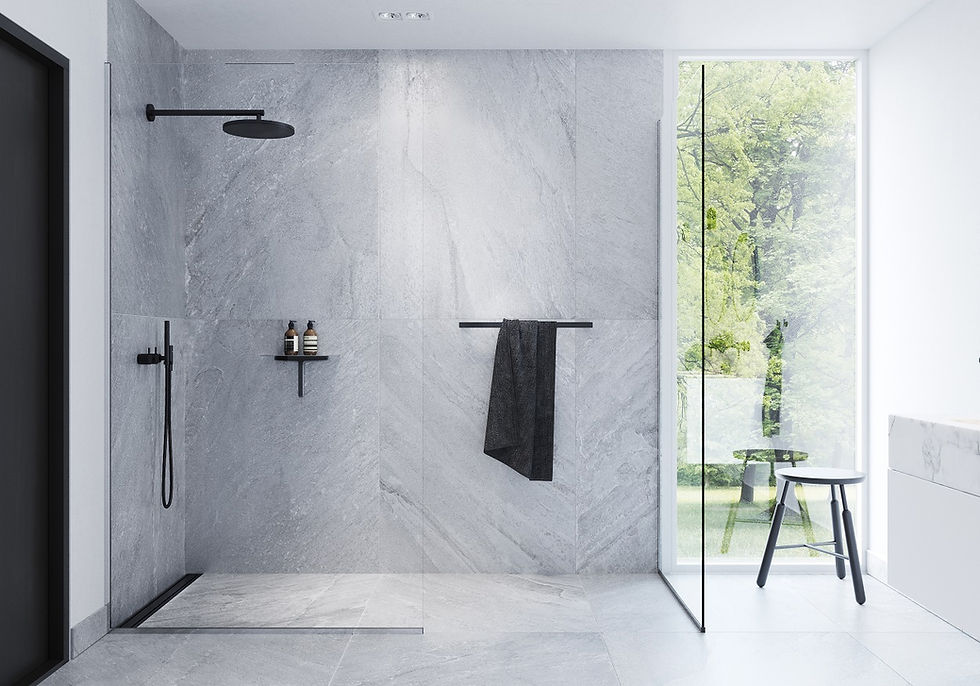Bathworks Guide To Wet Rooms
- Louise Hanley
- Apr 24, 2019
- 3 min read
Updated: Feb 28, 2025
Wet rooms are becoming the most desirable solution for showering spaces, offering aesthetical as well as functional benefits.
As well as captivating design enthusiasts with a sleek and attractive aesthetic, a wet room can offer many functional benefits that a regular shower enclosure cannot

But what is a wet room? … let’s first look at what a wet room consists of and what makes it different from a shower cubicle.
A wet room is a waterproof bathroom where the shower is either open or set behind a wall or screen, with the floor set on a slight gradient so that all water can drain away to an outlet in the floor.
From a design point of view, the flexibility offered by not being restricted by the footprint of a shower tray opens up ample solutions in creating a showering space in almost any room shape and size that more traditional showering enclosures are unable to match.
The open plan, minimal nature of a wet room creates a space efficient design which in turn adds practical benefits to the showering space. The most obvious benefit of level access showering is that it is instantly appealing for multi generational use.
Contrary to some general assumptions, wet rooms can be installed in any bathroom … even on timber floors!
The success of a wet room installation is highly dependant on a well planned design, quality drain system and professional expert installation. Meeting these requirements will ensure a beautiful wet room that can be enjoyed for many years and will help avoid some of the issues that can occur when this is not considered or followed such as poor drainage, ill-considered positioning and insufficient preparation that can create a host of unwelcome and costly problems when creating your wet room.

To create your dream wet room that you can enjoy for many years with peace of mind, the following principles need to be followed ::
Thorough and robust waterproofing
Correct floor slope within showering area
To ensure water flows towards the drain, the wet room floor should include an even 1.5% to
2% slope gradient within the showering area to the drain location. This gradient needs to take in to consideration the size and format of the floor tile being used. For example, a mosaic tile with more grout lines would require a greater gradient.
The slope should not be significant enough to be detected underfoot or contribute to a slippery surface. Poorly constructed slopes can cause water to pool on the floor, or run in the wrong direction, making the wet room difficult to dry and difficult to clean. This is one of the most common complications associated with wet rooms.
One option that helps to ensure success is to install a shower lay board system that incorporates the correct gradient required.
Solid foundations/ floor substrate
High volume drainage
Water spray radius
Screen the showering area from the rest of the bathroom
Louise’s Advice ::
· …. The shower … a shower that delivers a substantial water flow is a must! Don’t betray your wet room with a dribble of a shower! Embrace the experience and invest in a good quality power shower!
· While under tile heating may be thought of as a luxury addition to your bathroom. For me, when showering in a wet room it is one of MY musts!! …. Not only does it give you the comfort of a warm surface under your feet, it also has the functional benefit of drying up the the floor after showering!
· One of my favourite reasons for loving a wet room is the flexibility you have when designing the showering area …. No shower tray footprint! … no boundaries! … you can be really creative! Think stud wall with niche detail to accommodate all those bottles!
Foot niche to rest your foot on when washing your legs or shaving perhaps? … no more hopping on the one leg!
Or how about creating seating / bench area for those moments when you just want to sit down & relax in your amazing shower!
· A generous showering area can be enhanced by a heated towel rail. Warm towels within an easy reach or perhaps create a drying off area!







Comments